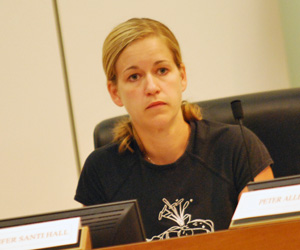Leveling the Field for Small Farms
Ann Arbor Greenbelt Advisory Commission meeting (July 14, 2010): Small farms and local food production again was a focus of the greenbelt advisory commission (GAC), as they considered revisions to easement language and scoring criteria for the greenbelt program.

Jennifer Santi Hall was elected chair of the city's greenbelt advisory commission at their July meeting, replacing Laura Rubin in that role. (Photos by the writer.)
The discussion prompted one commissioner, Dan Ezekiel, to underscore that they weren’t trying to favor small farms – they were simply trying to offset the advantages that the program has previously afforded to larger farms.
A review of revisions to the greenbelt program’s scoring criteria included a robust discussion about the meaning of “local food economy.” One of the proposed revisions would award points to farms that produce local food and contribute to the local food economy.
Commissioner Tom Bloomer, a Webster Township farmer, argued that all farms in Washtenaw County contribute to the local food economy, either directly or indirectly. Jennifer Santi Hall, who had proposed the change, agreed to withdraw the item from the scoring criteria so that they could refine the language. But she noted that it was important to find some way of including criteria for local food production, to align the scoring of applications with the greenbelt program’s strategic plan, which includes a section on the local food economy.
Later in the meeting, after nearly an hour in closed session to discuss land acquisition, the commission recommended allocating nearly $3 million in five separate deals, the majority of them for the purchase of development rights of local farms. Those recommendations will be forwarded to city council for final approval. [Full Story]





